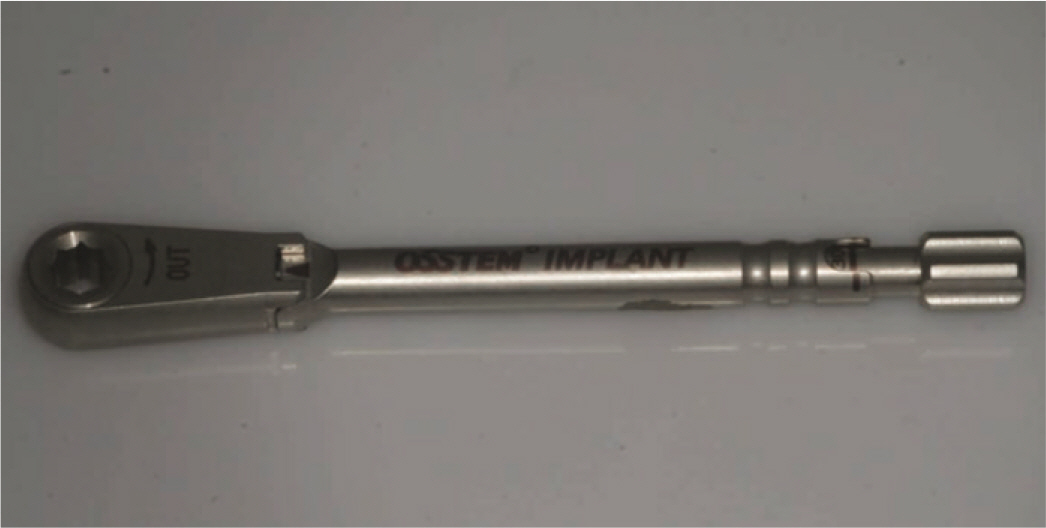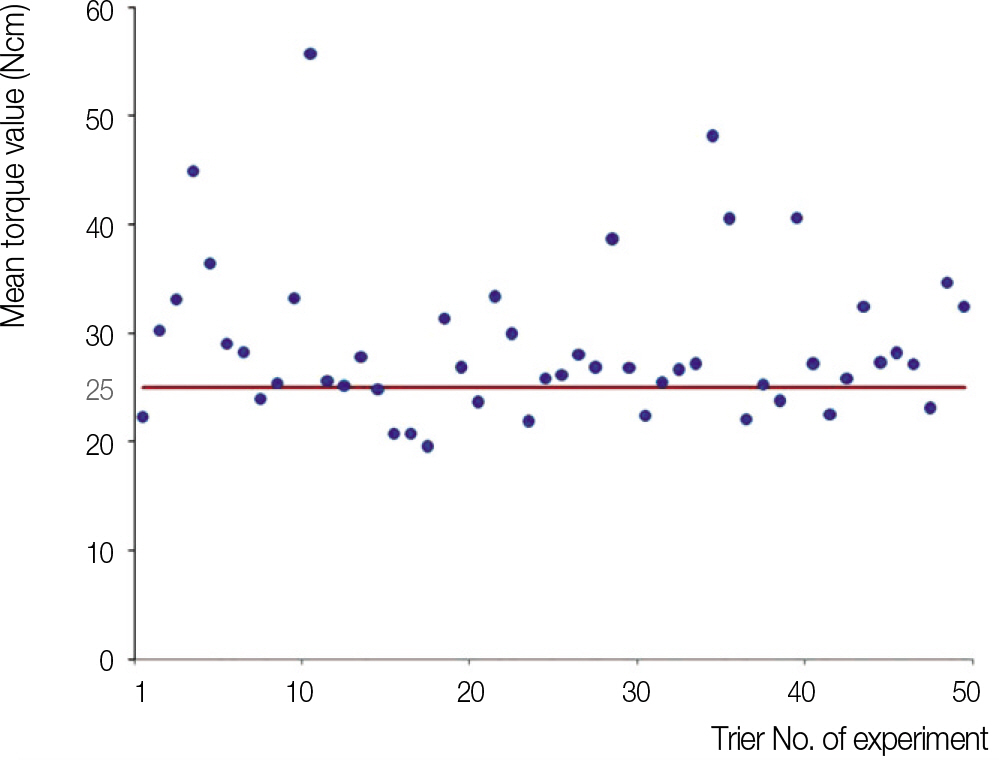J Korean Acad Prosthodont.
2011 Jul;49(3):197-205.
A study on accuracy and application of the implant torque controller used in dental clinic
- Affiliations
-
- 1Department of Prosthodontics, College of Dentistry, Wonkwang University, Iksan, Korea. porte93@wku.ac.kr
Abstract
- PURPOSE
This study was to evaluate the accuracy of the implant torque controller used in dental clinics and to investigate whether it was applied appropriately.
MATERIALS AND METHODS
Fifty dentists who work in dental clinics were enrolled in this study. Dental (implant) practice career, experience frequency of implant screw loosening and fracture, education of implant torque controller application and infection control methods were included in the survey. 25 Ncm and 30 Ncm of the tightening torque applied to the implant screw were measured by 50 clinicians. After measuring the torque value by using the torque controller, the torque mean according to where education about the implant torque controller was received was analyzed with independent t-test at the significance level of 0.05.
RESULTS
The torque controller used in private dental clinics showed 4.78% error ratio. When 50 dentists applied 25 Ncm to the implant screw was 29.0 +/- 8.4 Ncm, and that in 30 Ncm was 34.3 +/- 9.1 Ncm. Statistical significance was found between the group that was educated about implant torque application and the group that was not educated.
CONCLUSION
During the prosthodontic treatment with implant, there was difference between actual applied torsion force and the amount torque controller indicated. Clinicians have to not only be well-informed about the accurate usage method of the torque controller, but also keep and manage the torque controller so as to maintain continuous and accurate torque values. Through this, it is considered to achieve clinical results to minimize problems of screw loosening or fracture.
Figure
Reference
-
1.Jemt T., Pettersson P. A 3-year follow-up study on single implant treatment. J Dent. 1993. 21:203–8.
Article2.Goodacre CJ., Bernal G., Rungcharassaeng K., Kan JY. Clinical complications with implants and implant prostheses. J Prosthet Dent. 2003. 90:121–32.
Article3.Binon P. Screw joints, components, and other intimate relationships. J Prosthet Dent. 1994. 72:625.4.Cavazos E., Bell FA. Preventing loosening of implant abutment screws. J Prosthet Dent. 1996. 75:566–9.
Article5.Jaarda MJ., Razzoog ME., Gratton DG. Effect of preload torque on the ultimate tensile strength of implant prosthetic retaining screws. Implant Dent. 1994. 3:17–21.
Article6.Kim DG., Park CJ., Cho LR. Comparison of accuracy of implant torque controllers. J Korean Acad Stomatognathic Func Occl. 2008. 24:157–68.7.Gutierrez J., Nicholls JI., Libman WJ., Butson TJ. Accuracy of the implant torque wrench following time in clinical service. Int J Prosthodont. 1997. 10:562–7.8.Khraisat A., Hashimoto A., Nomura S., Miyakawa O. Effect of lateral cyclic loading on abutment screw loosening of an external hexagon implant system. J Prosthet Dent. 2004. 91:326–34.
Article9.Breeding LC., Dixon DL., Nelson EW., Tietge JD. Torque required to loosen single-tooth implant abutment screws before and after simulated function. Int J Prosthodont. 1993. 6:435–9.10.Patterson EA., Johns RB. Theoretical analysis of the fatigue life of fixture screws in osseointegrated dental implants. Int J Oral Maxillofac Implants. 1992. 7:26–33.11.Weinberg LA., Kruger B. A comparison of implant/prosthesis loading with four clinical variables. Int J Prosthodont. 1995. 8:421–33.12.Shin HM., Jeong CM., Jeon YC., Yun MJ., Yoon JH. Influence of tightening torque on implant-abutment screw joint stability. J Korean Acad Prosthodont. 2008. 46:396–408.13.Haack JE., Sakaguchi RL., Sun T., Coffey JP. Elongation and preload stress in dental implant abutment screws. Int J Oral Maxillofac Implants. 1995. 10:529–36.14.Tan KB., Nicholls JI. Implant-abutment screw joint preload of 7 hex-top abutment systems. Int J Oral Maxillofac Implants. 2001. 16:367–77.15.Rangert BR., Sullivan RM., Jemt TM. Load factor control for implants in the posterior partially edentulous segment. Int J Oral Maxillofac Implants. 1997. 12:360–70.16.Lazzara RJ. Criteria for implant selection: surgical and prosthetic considerations. Pract Periodontics Aesthet Dent. 1994. 6:55–62.17.McGlumphy EA., Mendel DA., Holloway JA. Implant screw mechanics. Dent Clin North Am. 1998. 42:71–89.18.Burguete RL., Johns RB., King T., Patterson EA. Tightening characteristics for screwed joints in osseointegrated dental implants. J Prosthet Dent. 1994. 71:592–9.
Article19.Jo ¨rne′us L., Jemt T., Carlsson L. Loads and designs of screw joints for single crowns supported by osseointegrated implants. Int J Oral Maxillofac Implants. 1992. 7:353–9.20.Dellinges M., Curtis D. Effects of infection control procedures on the accuracy of a new mechanical torque wrench system for implant restorations. J Prosthet Dent. 1996. 75:93–8.
Article21.Cehreli MC., Akça K., To ¨nu ¨k E. Accuracy of a manual torque application device for morse-taper implants: a technical note. Int J Oral Maxillofac Implants. 2004. 19:743–8.22.Jaarda MJ., Razzoog ME., Gratton DG. Providing optimum torque to implant prostheses: a pilot study. Implant Dent. 1993. 2:50–2.23.McGlumphy EA., Elfers CL., Mendel DA. A comparison of torsional ductile fracture in implant coronal screws [abstract]. J Dent Res. 1992. 71:114.24.Choi JH., Yang JH., Cho WP., Lee JB. The influence of abutment screw length and repeated tightening on screw loosening in dental implant. J Korean Acad Prosthodont. 2006. 44:432–42.25.Jang JK., Kim HJ., Chung Ch. Detorque force and surface change of coated abutment screw after repeated closing and opening. J Korean Acad Prosthodont. 2008. 46:500–10.
Article
- Full Text Links
- Actions
-
Cited
- CITED
-
- Close
- Share
- Similar articles
-
- Evaluation of fitness in implant screw as tightening torque in dental laboratory
- Accuracy of different electronic torque drivers: A comparative evaluation
- Accuracy of spring-style and friction-style mechanical implant torque wrench
- The combined effect of dismantling for steam sterilization and aging on the accuracy of spring-style mechanical torque devices
- THE EFFECTS OF FABRICATION AND TIGHTENING METHODS OF GOLD CYLINDER ON THE PRELOAD OF THE IMPLANT ABUTMENT














